Penguins
Issue date: 9th August 2023
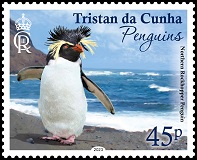 |
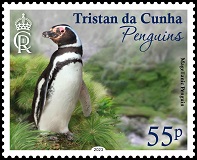 |
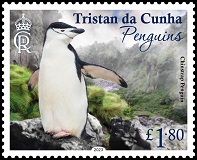 |
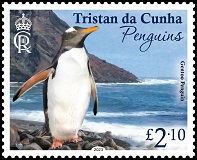 |
| 202310 | Mint Stamps (45p, 55p, £1.80, £2.10) | £4.90 |
| 202311 | First Day Cover (with 45p, 55p, £1.80, £2.10 stamps) | £6.10 |
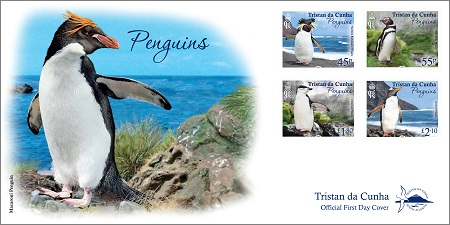
Not many realise that the UK is one of the world's top penguin nations. In some of the UK Overseas Territories in the Southern Hemisphere the shores are awash with waddling, tobogganing, and diving penguins – seven out of 18 penguin species are found in the Falklands, South Georgia & the South Sandwich Islands and Tristan da Cunha in the South Atlantic Ocean.
On Tristan, however, king, gentoo, macaroni, chinstrap and Magellanic penguins are only rare visitors to the archipelago that is home to 90% of the global population of northern rockhoppers.
Description of the Stamps
45p - Northern Rockhopper Penguins (Eudyptes moseleyi) are known by Islanders as Pinnamins. They are the most northern-breeding of the Eudyptes (crested) penguin species and occur in the temperate South Atlantic and southern Indian oceans, breeding on just seven islands between 37-40° S, five in the Tristan da Cunha group in the South Atlantic.
Owing to the species' restricted breeding range, a decline of 90-99% in the global population since the 19th century, and vulnerability to ever increasing land and sea-based threats such as changes in the marine environment, diseases, and oil pollution, rapidly growing seal populations, the northern rockhopper penguin has continued to be classified as Endangered by BirdLife International since 2008.
Northern rockhoppers like the shelter and protection of Spartina tussock grass as their breeding habitat which forms the rookeries on Nightingale, Inaccessible, and Middle islands. However, on Tristan itself and Gough Island, rookeries are found on the rocky shore, in gulches or under cliffs. Here penguins and their young are exposed to the elements, including wind and rain, and their nests are at higher risk to fail or being lost when the normally dry gulches flood after heavy rainfall.
Northern rockhoppers lay two eggs in early September at the Tristan da Cunha archipelago and about 3 weeks later on Gough Island. Incubation takes about 32-34 days and is divided into 2 shifts between males and females. Upon hatching, a single chick is guarded by the male for a further 20-26 days while the females provision the brood with food. After this time, when both parents forage simultaneously and leave their chick un-guarded, chicks gather into creches until they fledge in December or early January on Tristan and in January/February on Gough.
Rockhoppers, like all penguins, undergo an annual so called catastrophic moult in which they replace their entire plumage in one session. It is an energetically demanding time during which they return to shore to fast and stand (as still as possible to conserve energy) for several weeks until their new feathers have grown and been waterproofed. As a result, the penguin rookeries have a distinct aroma, and the peat soil is enriched with droppings, including feathers. This guano is harvested during annual trips by Tristan islanders during late summer to provide fertiliser for their Potato Patches.
Northern rockhopper penguins are one of the smallest penguin species, and probably one of the most agile. On Nightingale Island the penguins have to negotiate steep rock surfaces and as they hop up the rocks to feed their chicks each day it is easy to see how they got their name.
The Tristan Conservation Department works closely with the RSPB to study and to help protect this charismatic yet endangered species.
55p - Magellanic Penguins (Spheniscus magellanicus) belong to the genus of the 'banded' Spheniscus penguins and is found in South American, breeding along the coasts of Patagonia, including Argentina, Chile, and the Falkland Islands, with some migrating to Brazil and Uruguay, and with vagrants occasionally venturing further north. In one study a bird travelled 1,663 miles in 75 days.
Magellanic penguins breed under vegetation or in burrows that can be up to 2m deep with a nest chamber slightly higher than the tunnel to protect eggs from rain and wind.
Despite the great distributional breeding range of Magellanic penguins their numbers have, like other penguins, slowly been declining.
£1.80 - Chinstrap Penguins (Pygoscelis antarcticus) are a rare visitor to Tristan. The penguin gets its common name from the narrow black band across its cheek making it look like it's wearing a black helmet.
Chinstraps are abundant, with a circumpolar distribution in the Antarctic and sub-Antarctic regions (Bouvet (Norway), South Orkneys, South Shetland, South Georgia & the South Sandwich Islands, Heard and the Balleny Islands). Vagrants have also been found in New Zealand, the islands of Saint Helena, and Tristan da Cunha). The global population is estimated to be in the region of ~8 million mature individuals and on some islands, enormous colonies of chinstrap penguins can exceed several 100,000s pairs. While the species has expanded its range and its population in the mid-20th century, numbers are currently decreasing at the species' northern range. Climate change is potentially the greatest threat to this species as, in several parts of its range, changes in their environment can negatively impact the abundance of krill which makes reproduction less successfully.
£2 - Gentoo Penguins (Pygoscelis papua) are another rare and accidental visitor to Tristan, breeding circumpolar; on the Antarctic Peninsula and sub-Antarctic islands across the Southern Ocean from the Falkland Islands, and South Georgia & the South Sandwich Islands in the South Atlantic to Macquarie Island in the South Pacific. The total breeding population is estimated to be 774,000 mature birds. Gentoos breed monogamously and infidelity is typically punished with banishment from the colony.
Although still numerous, the species faces many threats that include pollution, hunting, fishing and human recreational activities.
FDC - Macaroni Penguins (Eudyptes chrysolophus)) are a species of penguin found from the sub-Antarctic to the Antarctic Peninsula.
After spending the summer breeding, penguins disperse into the oceans for six months. While foraging for food, groups will range north to the islands off Australia, New Zealand, southern Brazil, Tristan da Cunha, and South Africa. A 2009 study found that macaroni penguins from Kerguelen travelled over 10,000 km (6,200 mi) in the central Indian Ocean. With about 18 million individuals, the macaroni penguin is the most numerous penguin species. Widespread declines in populations have been recorded since the mid-1970s and their conservation status is classified as vulnerable.
Technical Specifications from Pobjoy Mint Ltd.
| Designer: | Andrew Robinson | Stamp size: | 38 x 30.6mm |
| Printer: | Cartor | Perforation: | 13 x 13¼ per 2cms |
| Process: | Lithography | Layout: | 10 |
| Production Co-ordination: | Creative Direction (Worldwide) Ltd |
